C语言学习心得体会
在科技高度发展的今天,计算机在人们生活、学习和工作中的作用越来越突出。我们都知道C语言是一种计算机语言,而作为计算机专业的我们学习它,就更有助于我们更好的了解计算机,与计算机进行交流,因此,C语言的学习对我们尤其重要。
说实话这个学期刚开始学C语言的时候,很感觉迷茫,对里面的好多东西很陌生,在操作运用的时候感到很棘手,毕竟,万事开头难嘛。在此之前从没有接触过C语言,有点摸不着头脑。可是在上机过后,我觉得编程是很有趣的一件事,哪怕你编出的只是一个很简单的程序都会让你很有成就感。我知道要学好C语言不容易,可是我决定完成这件不容易的事。
在课堂上老师从最基本的跟我们讲起,要学好C语言就必须要先懂得最基本的语法知识,看课本是必需的。我觉得看不懂也没关系,尽力去理解就好了,在对知识有了一个大致的了解过后,就要上机实践。学习C语言一定要动手,只看不做,眼高手低是不行的。
最开始我们打书上的例题,熟悉程序,慢慢的开始试着编程。老师说过在编程时要理清自己的思路,然后再转换成C语言中的语言,这个时候就更要动手了,只有通过上机操作才能验证自己程序的正确性。执行程序,不要害怕错误,其实,我觉得错误是好的,知道了自己所学知识的不足,并根据提示改正程序中发生的错误,一种成就感油然而生,觉得自己的付出都是值得的。
我觉得良好的编程习惯是学好C语言的重要因素,只有勤动手,多动脑才能学好C语言,光说不练是不行的。在学习的时候,不会的一定要问明白,可以求助于老师,同学,不要自己一个人钻牛角尖,既浪费时间又学不到东西。
上课的时候也一定要认真听,老师讲的肯定是最重要的,错过了就是一大笔损失,认真听讲才可以提高学习效率嘛。另外我觉得在编程之前,要把自己的想法写在纸上,如果是简单一点的程序不需要这样,如果程序比较复杂,就写下来,这样可以让思路更加清晰。
输入程序时一定要认真,不要把“,”与“;”混淆,用scanf的时候不要忘记“&”,用“switch”要记得“break”,用if,while的时候注意不要加“;”,“{}”“()”一定要配对,不要多也不要少一半,“=”与“==”的区别要清楚,要勤查优先级,要记住一些基本的,例如两个值之间的调换怎么写等等。
学习C语言需要的是坚持下去的毅力和认真对待每次错误的耐心,还有孜孜不倦的努力。拥有一个良好的心态,相信自己,你就会发现学好C语言不再困难!
第二篇:c语言学习心得
C语言学习心得
C语言是一门低级计算机编程语言,设计目标是提供一种能以简易的方式编译、处理低级存储器、产生少量的机器码以及不需要任何运行环境支持便能运行的编程语言。C语言也很适合搭配汇编语言来使用(往往可以通过内联汇编语言或与汇编语言目标文件一起连接。对于任何一种操作系统环境,C函数的ABI与汇编语言的子过程
刚开始学C语言的时候,很迷茫,在此之前从没有接触过C语言,有点摸不着头脑。可是在上机过后,我觉得编程是很有趣的一件事。我知道要学好C语言不容易,可是我决定完成这件不容易的事。
要学好C语言就要先懂得最基本的语法知识,看课本是必需的。我觉得看不懂也没关系,尽力去理解就好了,在对知识有了一个大致的了解过后,就要上机实践。学习C语言一定要动手,只看不做,眼高手低是不行的。最开始可以打书上的例题,熟悉程序,慢慢的开始试着编程。在编程时要理清自己的思路,然后再转换成C语言中的语言,这个时候就更要动手了,只有通过上机操作才能验证自己程序的正确性。执行程序,不要害怕错误,其实,我觉得错误是好的,知道了自己所学知识的不足,并根据提示改正程序中发生的错误,一种成就感油然而生,觉得自己的付出都是值得的。
良好的编程习惯是学好C语言的重要因素,只有勤动手,多动脑才能学好C语言,光说不练是不行的。
经过第一阶段对语法的学习,我觉得实例阶段应该是一个过渡阶段吧,通过前一阶段对语法的学习之后,可能有很多概念我们都比较模糊,或者说很多东西太抽象了,这就为我们第二个阶段的学习做好了实例化的准备,可以这样说吧,第一个阶段就我们为我们的学习一样东西而构建的一个类,里面讲了我们应该在这里面要做什么?第二阶,也就是本阶段,我们就应该去把前一段的东西具体化,那怎么个具体化呢,练习一些小例子,从网上下载的电子书上有很多这方面的例子的,如果有自己去书店买书的话,里面也应该提供了不少,里面的例子,我是每次都打了一遍,也许有的人不会亲自去用手打一遍,什么copy等,当然这样也行,但我个人认为,对于初学者来说,最好还是自己动力打一遍比较好,毕竟这些东西对我们来说,都比较陌生,如果每个字都自己打完的话,有些代码你不想记住也难了,在这里,我们得弄懂练习的每一个例子,如果能把一些例子稍稍修改,弄懂里面精髓的东西,让自己知道为什么这样做,那么是最好不过的了,我平时练习时,这一步是少不了的,都习惯了,所以也就成了条件反射,想不这样都不行。最后,我们就应该汇一下总,把前面做过的例子里所用的技术理一下,再做一个比较大的例子,尽量把到目前为止所懂的知识全部应用到里面去,只是
尽量,当然有些东西是不能集成到一起的,也是是代码之间的排斥性。
学习C语言需要的是坚持下去的毅力,认真对待每次错误的耐心,还有孜孜不倦的努力。拥有一个良好的心态,相信自己,你就会发现学好C语言不再困难!
第三篇:学习语言学的感想
We can study Linguistics from three parts: introduction to Linguistics, main branches of Linguistics, main theories about Linguistics.
The introduction to Linguistics is made up of design feature of language, language families, important distinctions in Linguistics and scope of Linguistics.
Design features refer to the defining properties of human language that distinguish it from any animal system of communication. The following are the most distinguished properties: creativity, arbitrariness, displacement, cultural transmission and duality.
Creativity, in other words, language can be used to create new meanings because of its duality.
Arbitrariness is the forms of human language demonstrate a property.
Displacement. Language can refer to contexts removed from the immediate situations of the language user. This property of human language is called displacement.
Cultural transmission is the process whereby language is passed on and on from one generation to the next.
Duality is the property of having two levels of structures, such that units of the primary level are composed of elements of the secondary level. For example: Sounds > syllables > words > phrases > clauses > sentences> texts/discourses
There are some important distinctions in Linguistics: descriptive & prescriptive, synchronic & diachronic, langue & parole, competence & performance.
Descriptive is describing how things are. Prescriptive is prescribing how things ought to be.
For example: Don't say X. People don't say X. The first is a prescriptive command, while the second is a descriptive statement.
Synchronic is to take a fixed instant as its point of observation. Diachronic is the study of a language through the course of its history.
Langue refers to the abstract linguistic system shared by all members of a speech community. Parole refers to realization of language in actual use. It is one of the most important distinctions in linguistics introduced by Sassure (father of modern linguistics) in his Course in General Linguistics.
Competence is user's knowledge of rules about the linguistic system. Performance is the actual realization of this knowledge in concrete situations. It is introduced by Chomsky between general linguistic ability and individual language use, which is connected to de Sassure’s distinction langue vs. parole.
In terms of the number of individual speakers and individual languages, four language families are considered to be the most important, namely, the Indo-European Family, the Sino-Tibetan Family, the Austronesian Family, and the Afroasiatic Family.
There are several kinds of classifications of Linguistics.
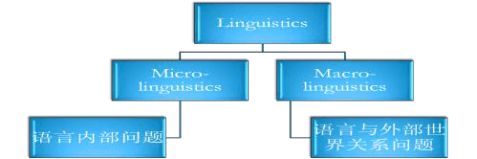
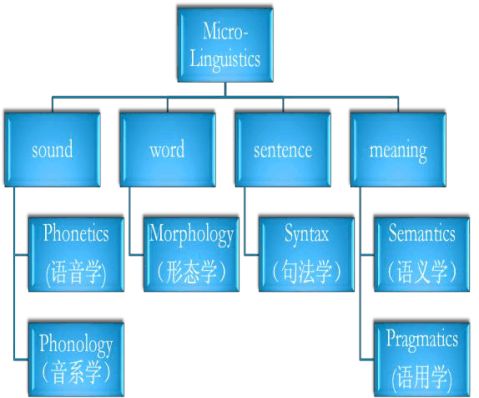
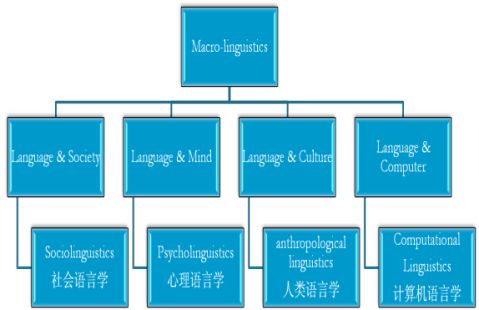
Phonetics studies all speech sounds in human languages: how they are produced, transmitted and how they are received.
Phonology aims to discover how speech sounds in a language form patterns and how these sounds are used to convey meaning in linguistic communication.
Classification of Phonetics: articulatory phonetics(发音语音学)--speaker’s production, acoustic phonetics(声学语音学)--transmission’s medium, auditory phonetics(听觉语音学)--receiver’s reception.
How speech sounds are made? This is a picture about the speech organs.
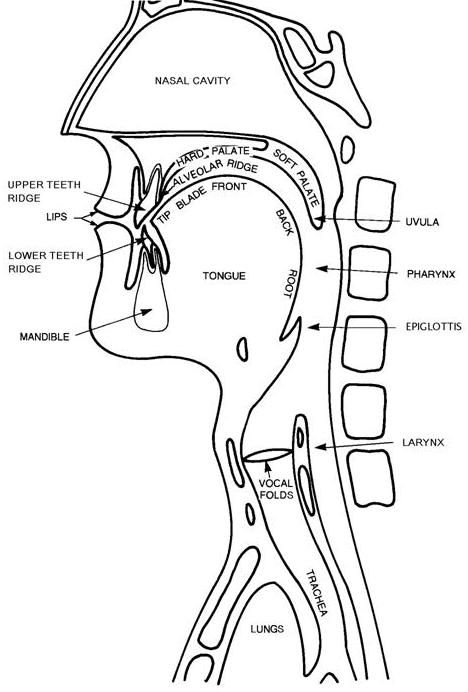
Position of the vocal folds(声带) connects with: voicing(浊音) and voiceless (清音)
Voiceless(清音):vocal cords are drawn wide apart, letting the air stream go through without causing obstruction. Eg.:[p,s,t]
Voicing/Voiced(浊音):vocal cords held together, letting the air stream vibrates. Eg.: [b,z,d]
The distinction between vowels and consonants lies in the obstruction of airstream. As there is no obstruction of air in the production of vowels, the description of the consonants and vowels cannot be done along the same lines.
Phonology is the study of how speech sounds in a language form patterns and how these sounds are used to convey meaning in linguistic communication. There are some important definitions in phonology: phone音子,phoneme音位 (音系研究的基本单位), supra-segmental features超音段特征.
Phone(音子):a phonetic unit; the speech sounds we hear and produce during communication are all phones. For example: too 和 tea 中的 /t/. 发too中的/t/时, 舌位更靠近口腔前部.发tea中的/t/时,舌位更靠近口腔后部. 所以too 和 tea 中的 /t/两个不同的音子.
Phoneme(音位): phonological and abstract unit, a unit of distinctive value; the smallest unit of sound in a language which can distinguish two words. For example: tea 和 sea, /t/和/s/是两个不同的音位morpheme
Suprasegmental features (超音段特征) :phonemic features that occur above the level of the segments . The principal suprasegmentals are: syllable, stress, tone, intonation.
Morphology focuses on the study of the internl structure of words and ways to form words.
morpheme(语素)is the most basic element of meaning in language,an element that cannot be further divided into smaller units without altering its meaning.

Morpheme may be classified in more than one dimension. Firstly, morphemes are bound morphemes are free morphemes. Free morphemes(自由语素) are those that may constitute words by themselves, eg boy, girl, table, nation. Bound morphemes(黏着)are those that cannot occur alone, eg -s, -ed, dis-, un-. Inflectional morpheme (屈折语素)=inflectional affix(屈折词缀):change the grammatical meaning (number, aspect, case, tense). Derivational morpheme(派生语素)=inflectional affix (派生词缀): change the lexical meaning.
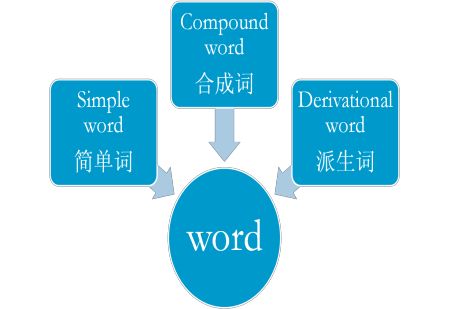

Syntax is the study of how words combine to form sentences and the rules which govern the rules which govern the formation of sentences. Category(范畴): a group of linguistic items which fulfill the same or similar functions in a particular language such as sentence, a noun phrase or a verb (起相同作用的一类语言单位). Syntactical category(句法范畴): a group of linguistic items which fulfill the same or similar functions in sentence-formation. (在句子构成中起相同作用的一类语言单位)Word--lexical category. Phrase--phrasal category. Clause--clausal category.
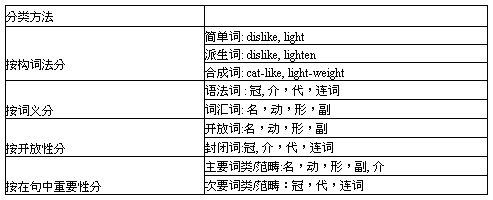
Semantics can be classified into four kinds by different studies, namely, Linguistic Semantics, Logical Semantics, Philosophical Semantics and General Semantics.
The sense relation of words falls into five aspects: polysemy, homonymy, synonymy, antonymy and hyponymy. Polysemy refers to the phenomenon that the same word may have a set of different meanings. Homonyms are generally defined as words different in meaning but either identical in sound and spelling or identical only in sound or spelling. Synonymy is one of the basic features of any natural language. Antonymy can be defined as words which are opposite in meaning. Hyponymy refers to the hierarchical relationship between meanings of general and specific lexical items.
Pragmatics can be identified by this formula: Pragmatics=meaning-semantics.
Speech Act Theory: John Austin (1911-1960). How to Do Things with Words (1962). Main Idea: things can be done with words.
Constatives(叙事句)are utterances which roughly serves to state a fact, report that something is the case, or describe what something is, eg: I go to the park every Sunday.
Performatives(施为句)are utterances which are used to perform acts, do not describe or report anything at all; the uttering of the sentence is the doing of an action; they cannot be said to be true or false. Performative verbs: name, bet, etc.
Three Speech Acts (三种言语行为): A locutionary act (言内行为): the act of uttering words, phrase, sentences. It is an act of conveying literal meaning by means of syntax, lexicon and phonology. An illocutionary act(言外行为): an act of expression speaker’s intention; it is an act performed in saying something. A perlocutionary act(言后行为): the act preformed by or as a result of saying, the effects on the hearer. For example: 老师对学生说: You have left the door open. Locutionary act(言内行为): the act of uttering the words of “you”, “have”, “left”, “the”, “door”, “open” Illocutinary act(言外行为): the act of expressing the teacher’s intention of asking the student to close the door. Perlocutionary act(言后行为): the effect of the utterance: student goes to close the door.
The Cooperative Principle (CP,合作原则): Maxim of Quality(数量准则). Maxim of Quantity(质量准则). Maxim of Relation(关系准则). Maxim of Manner(方式准则)
